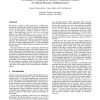84 search results - page 12 / 17 » Anonymizing sequential releases |
ASPLOS
1991
ACM
14 years 2 months ago
1991
ACM
The memory consistency model supported by a multiprocessor architecture determines the amount of buffering and pipelining that may be used to hide or reduce the latency of memory ...
CEAS
2004
Springer
14 years 4 months ago
2004
Springer
: We describe methods for automatically identifying signature blocks and reply lines in plaintext email messages. This analysis has many potential applications, such as preprocessi...
HICSS
1999
IEEE
14 years 3 months ago
1999
IEEE
The behavior of Distributed Shared Memory Systems is dictated by the Memory Consistency Model. Several Memory Consistency Models have been proposed in the literature and they fit ...
SIGMOD
2005
ACM
14 years 11 months ago
2005
ACM
A number of organizations publish microdata for purposes such as public health and demographic research. Although attributes that clearly identify individuals, such as Name and So...
EDBTW
2010
Springer
14 years 5 months ago
2010
Springer
Organizations often need to release microdata without revealing sensitive information. To this scope, data are anonymized and, to assess the quality of the process, various privac...

